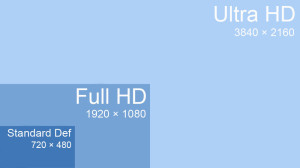With the rapid advancement of TVs or cameras, high resolutions play an ever greater role. Especially when it comes to movies with impressive landscapes, not only movie fans want to be able to perceive even the smallest details in the best possible quality. The new standard, Ultra HD, combines all of these requirements and is already supported by our KVM extender DL-Vision.
What is Ultra HD?

In the next years, Full HD, also known as 1080p, will be gradually replaced by Ultra HD. With a resolution of 3840 × 2160 pixels and eight million pixels, Ultra HD offers four times as many pixels as Full HD. In the future, both colour space and colour resolution will also be significantly greater than with Full HD resolutions.
The change from Full HD to Ultra HD also allows higher frame rates. Instead of the usual 24 frames per second, movies can now be recorded with 48 frames per second. Movies or videos are displayed at 50 or 60 Hertz.
Indulging in new worlds
Due to the high resolution and the many details that are visible especially on large screens, nowadays Ultra HD is often used when filming movies with complex, detailed worlds. Therefore, it came as no surprise that Peter Jackson used the 4k resolution for the Hobbit trilogy. And for the upcoming Avatar sequels, James Cameron announced that he plans on making the fantasy world Pandora even more colourful and livelier using Ultra HD.
Application in KVM

But not only moviegoers can benefit from the introduction of Ultra HD. The 4k resolution also facilitates professional video signal processing and monitoring comprehensive control room processes in different broadcast applications. Thanks to Ultra HD many application processes can be displayed simultaneously on a single large format display. To keep workplaces free from computers yet still be able to work with leading-edge technology, staff from editing studios, CAD and 3D studios especially benefit from the KVM extender DL-Vision and its ability to transmit Ultra HD at full frame rate (60 Hz).
Of course, the change from Full HD to Ultra HD won’t happen over night. But with our devices, today’s broadcasters can already work with the technologies of tomorrow.
- Trade shows 2023: Experience G&D KVM products live and up close - 11. January 2023
- Innovative KVM solutions for control rooms - 14. December 2022
- Ada Lovelace – a true visionary and the world’s first female programmer - 12. December 2022


One thought on “Ultra HD: a new standard from Germany to Pandora”